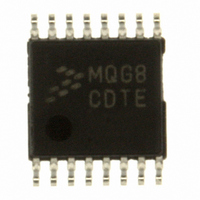MC9S08QG8CDTE Freescale Semiconductor, MC9S08QG8CDTE Datasheet - Page 208

MC9S08QG8CDTE
Manufacturer Part Number
MC9S08QG8CDTE
Description
IC MCU 8K FLASH 10MHZ 16-TSSOP
Manufacturer
Freescale Semiconductor
Series
HCS08r
Datasheet
1.MC9S08QG8CDTER.pdf
(314 pages)
Specifications of MC9S08QG8CDTE
Core Processor
HCS08
Core Size
8-Bit
Speed
20MHz
Connectivity
I²C, SCI, SPI
Peripherals
LVD, POR, PWM, WDT
Number Of I /o
12
Program Memory Size
8KB (8K x 8)
Program Memory Type
FLASH
Ram Size
512 x 8
Voltage - Supply (vcc/vdd)
1.8 V ~ 3.6 V
Data Converters
A/D 8x10b
Oscillator Type
Internal
Operating Temperature
-40°C ~ 85°C
Package / Case
16-TSSOP
Cpu Family
HCS08
Device Core Size
8b
Frequency (max)
20MHz
Interface Type
I2C/SCI/SPI
Total Internal Ram Size
512Byte
# I/os (max)
12
Number Of Timers - General Purpose
1
Operating Supply Voltage (typ)
2.5/3.3V
Operating Supply Voltage (max)
3.6V
Operating Supply Voltage (min)
1.8V
On-chip Adc
8-chx10-bit
Instruction Set Architecture
CISC
Operating Temp Range
-40C to 85C
Operating Temperature Classification
Industrial
Mounting
Surface Mount
Pin Count
16
Package Type
TSSOP
Processor Series
S08QG
Core
HCS08
Data Bus Width
8 bit
Data Ram Size
512 B
Maximum Clock Frequency
20 MHz
Number Of Programmable I/os
12
Number Of Timers
1
Operating Supply Voltage
1.8 V to 3.6 V
Maximum Operating Temperature
+ 85 C
Mounting Style
SMD/SMT
3rd Party Development Tools
EWS08
Development Tools By Supplier
DEMO9S08QG8E
Minimum Operating Temperature
- 40 C
Package
16TSSOP
Family Name
HCS08
Maximum Speed
20 MHz
For Use With
DEMO9S08QG8E - BOARD DEMO FOR MC9S08QG8
Lead Free Status / RoHS Status
Lead free / RoHS Compliant
Eeprom Size
-
Lead Free Status / Rohs Status
Compliant
Available stocks
Company
Part Number
Manufacturer
Quantity
Price
Company:
Part Number:
MC9S08QG8CDTE
Manufacturer:
ABB
Quantity:
101
Company:
Part Number:
MC9S08QG8CDTE
Manufacturer:
Freescale Semiconductor
Quantity:
41 991
Part Number:
MC9S08QG8CDTE
Manufacturer:
FREESCALE
Quantity:
20 000
Serial Communications Interface (S08SCIV3)
14.3.3
Receiver Functional Description
In this section, the receiver block diagram
(Figure
14-4) is used as a guide for the overall receiver
functional description. Next, the data sampling technique used to reconstruct receiver data is described in
more detail. Finally, two variations of the receiver wakeup function are explained.
The receiver is enabled by setting the RE bit in SCIC2. Character frames consist of a start bit of logic 0,
eight (or nine) data bits (LSB first), and a stop bit of logic 1. For information about 9-bit data mode, refer
to
Section 14.4.1, “8- and 9-Bit Data
Modes.” For the remainder of this discussion, we assume the SCI is
configured for normal 8-bit data mode.
After receiving the stop bit into the receive shifter, and provided the receive data register is not already
full, the data character is transferred to the receive data register and the receive data register full (RDRF)
status flag is set. If RDRF was already set indicating the receive data register (buffer) was already full, the
overrun (OR) status flag is set and the new data is lost. Because the SCI receiver is double-buffered, the
program has one full character time after RDRF is set before the data in the receive data buffer must be
read to avoid a receiver overrun.
When a program detects that the receive data register is full (RDRF = 1), it gets the data from the receive
data register by reading SCID. The RDRF flag is cleared automatically by a 2-step sequence which is
normally satisfied in the course of the user’s program that handles receive data. Refer to
Section 14.3.4,
“Interrupts and Status
Flags,” for more details about flag clearing.
14.3.3.1
Data Sampling Technique
The SCI receiver uses a 16× baud rate clock for sampling. The receiver starts by taking logic level samples
at 16 times the baud rate to search for a falling edge on the RxD1 serial data input pin. A falling edge is
defined as a logic 0 sample after three consecutive logic 1 samples. The 16× baud rate clock is used to
divide the bit time into 16 segments labeled RT1 through RT16. When a falling edge is located, three more
samples are taken at RT3, RT5, and RT7 to make sure this was a real start bit and not merely noise. If at
least two of these three samples are 0, the receiver assumes it is synchronized to a receive character.
The receiver then samples each bit time, including the start and stop bits, at RT8, RT9, and RT10 to
determine the logic level for that bit. The logic level is interpreted to be that of the majority of the samples
taken during the bit time. In the case of the start bit, the bit is assumed to be 0 if at least two of the samples
at RT3, RT5, and RT7 are 0 even if one or all of the samples taken at RT8, RT9, and RT10 are 1s. If any
sample in any bit time (including the start and stop bits) in a character frame fails to agree with the logic
level for that bit, the noise flag (NF) will be set when the received character is transferred to the receive
data buffer.
The falling edge detection logic continuously looks for falling edges, and if an edge is detected, the sample
clock is resynchronized to bit times. This improves the reliability of the receiver in the presence of noise
or mismatched baud rates. It does not improve worst case analysis because some characters do not have
any extra falling edges anywhere in the character frame.
In the case of a framing error, provided the received character was not a break character, the sampling logic
that searches for a falling edge is filled with three logic 1 samples so that a new start bit can be detected
almost immediately.
MC9S08QG8 and MC9S08QG4 Data Sheet, Rev. 5
206
Freescale Semiconductor











